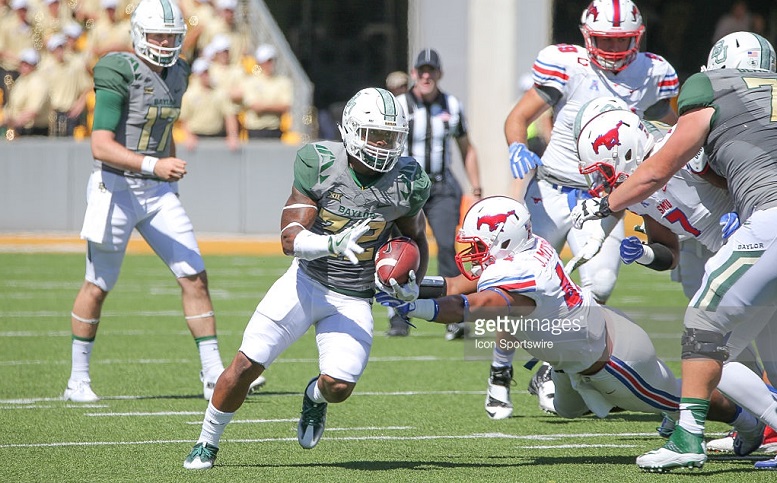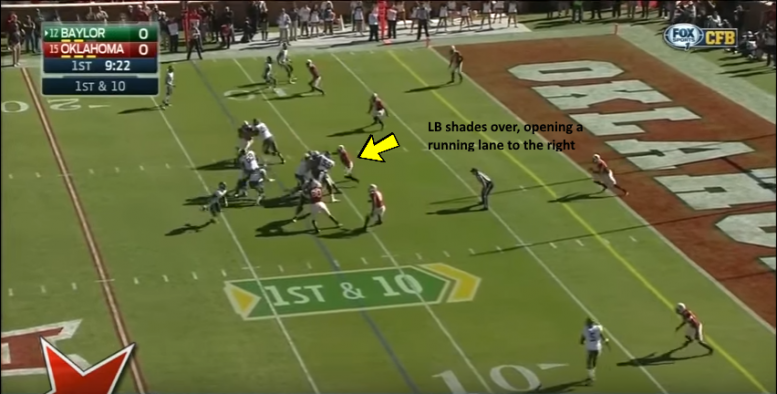From now until the 2017 NFL Draft takes place, we hope to showcase as many prospects as possible and examine both their strengths and weaknesses. Most of these profiles will feature individuals that the Pittsburgh Steelers are likely to have an interest in, while a few others will be top-ranked players. If there is a player you would like us to analyze, let us know in the comments below.
#32 Shock Linwood / RB / 5’9 200 lbs
The Good:
– Smooth transition in second gear
– Impactful stiff arm move
– High cut runner with great lateral agility
– Plus vision, can make the most out of carry
– Tough nosed runner
The Bad:
– Has tendency to bounce outside
– Undersized for the next level
– Non-factor as a receiving threat
– Could be more patient when waiting for inside lanes to develop
– Needs to clean up mental errors in pass protection
Bio:
– 2016: 138 carries, 751 yards, 5.4 YPC, 2 TDs
– Career: 713 carries, 4213 yards, 5.9 YPC, 36 Rushing TDs
– 9 receptions are a career high for receptions in a season
– 2015 and 2014 All Big 12 Selection
– 2013 Freshman All American
– Holds Baylor record for most rushing yards in school’s history with 4213 yards
– Fifth most rushing yards (4213) in Big 12 Conference history
Tape Breakdown:
Baylor running back Shock Linwood is as savvy as running backs come. Linwood was that kid on the playground who always got selected first in pickup football games as his speed and elusiveness outmatched all the other competitors. Now at Baylor, Linwood is still that kid on the playground who was too fast and too quick for anyone to keep up with.
Linwood possesses great lateral agility that is capable of making any defender miss. With a hard-high cut move, Linwood leaves defenders confused as they wonder where the Baylor running back has gone. But by this time, Linwood has already made it halfway up the field.
For undersized running backs who do not have the size advantage to break tackles, they must have an ability to create hidden yardage somehow. Linwood is one of the best at this, as his speed and agility can turn a 3-yard gain into a potential 30-yard.
While the play above showcased the running back’s agility, this is not the only weapon in his arsenal. Part of the reason why Linwood became Baylor’s all-time leading rusher is because of his easy transition into second gear. Linwood can explode through a running lane and easily take second levels by surprise with his speed.
As Linwood follows his pulling guard off tackle, he accelerates into the secondary too quickly for the Iowa State defenders to get even a hand on him. The second level should perhaps be re-named ‘No Man’s Land’ as it is a highly dangerous area of the field once Linwood steps into it. Linwood’s open field ability and his skillset make him an almost impossible player to square up and bring down at the second level.
Earlier I spoke about Linwood’s ability to turn a 3-yard gain into a 30-yard gain, foreshadowing what was approaching. Watch on the play below as Linwood, almost magically, escapes a group of defenders and turns in a big gain.
Linwood’s composure shines through on the play above, The Baylor running back does not panic with defenders approaching him, instead remaining calm and running towards the opposite sideline. While many running backs would be unable to replicate a play like this, Linwood knows that almost no defender can match his speed to the perimeter.
A pattern now starts to form on all of Linwood’s plays posted above – they are all runs to the perimeter. Playing in Baylor’s spread offense, Linwood did not take any pro style handoffs and as you may expect, he does tend to struggle when running up an interior running lane.
In the play above, Linwood is stopped for a short gain. While it just seems like an average every down running play, Linwood did miss the opportunity to do something more on the play above. Perhaps unable to see in game speed, here is a still image that better exhibits Linwood’s missed opportunity.
As Linwood approaches the line, the Oklahoma inside linebacker shades over to Linwood’s left, leaving an open running lane open on the right side. Linwood chooses to stay left and plays right into the linebacker’s hand, being stopped for a short gain. You often hear Pittsburgh Steelers’ running back Le’Veon Bell speak of how he reads the inside linebacker’s feet after the snap to determine which hole to pursue. And while it would be unfair to criticize a college running back for not showing the same instincts as one of the NFL’s better backs, it is something that Linwood must improve on as he adjusts to the NFL’s style of running.
At the next level, Linwood will not enjoy the benefit of being the fastest player on the field but he does offer potential as a change of pace back. Linwood would be a great asset to substitute in when a team is facing an exhausted defense. A third down back duty for Linwood cannot be ruled out as well, as even though the running back only grabbed a few receptions during his career, it was not because of bad hands, rather Baylor’s scheme did not make him a primary receiving option.
Projection: Late Day Three (Round 6-7)
Games Watched: vs Iowa State (2016), vs Iowa State (2015), vs Oklahoma, vs Kansas













